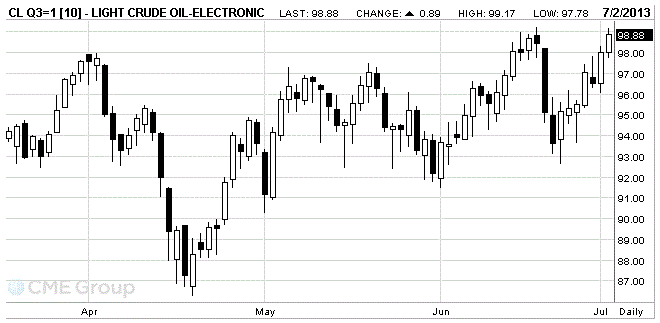Notícias do Mercado
-
16:40
Oil: an overview of the market situation
Oil prices rose modestly, while continuing yesterday's gain, which was due to concerns over supply disruptions from Libya, as well as political unrest in Egypt, which may hit oil supplies from the region.
It is learned that oil production in Libya has fallen to third place, after the protestors closed several fields, as anti-government demonstrations in Egypt have raised concerns about the stability of the entire region.
Prices were also supported by yesterday's data from the Institute for Supply Management, which showed that the results of last month's U.S. manufacturing activity grew.
Experts note that many investors took the opportunity to buy oil at relatively low prices after three consecutive quarters of decline, which was the longest string of losses since the 1997-1998. Analysts also point to the probability of an increase in refining capacity in the near future.
Meanwhile, it is worth noting that Canada yesterday resumed work on the part of a major pipeline in Alberta, which was due to improved weather conditions.
Higher prices also contribute to the expectations of tomorrow's publication of data on oil reserves in the United States.
We also add that today its reserves data will present the American Petroleum Institute (API). Analysts expect the reduction of oil reserves by 2.63 million barrels last week, increasing the fuel reserves of 600 million barrels, distillate - by one million barrels.
The cost of the August futures on U.S. light crude oil WTI (Light Sweet Crude Oil) rose to 97.96 dollars a barrel on the New York Mercantile Exchange.
August futures price for North Sea Brent crude oil mixture rose $0.62 to $ 103.58 a barrel on the London exchange ICE Futures Europe.

-
16:20
Gold: an overview of the market situation
Gold prices fell slightly today, and not being able to hold the position previously won, and broke a series of two-day growth in a row. Experts point out that this trend was due to the unexpected, and at the same time, the sharp strengthening of the dollar, as well as the expectations of the information regarding the scope of the program of bond purchases.
Note that during the first half of the trading price of gold showed growth, as traders were forced to cover their short positions against the background of much restoration, which followed after the biggest three-month fall since at least 1968. We also add that the closing of positions was due to expectations of the publication of the report on non-farm payrolls, which will be presented at the end of this week. Meanwhile, many investors are afraid to enter the market on the eve of Independence Day in the United States.
Gold lost 23% in the period from April to June, on speculation that the current monetary policy of the Federal Reserve System may be revised in the near future. This will contribute to an increase in interest rates, and to make gold less attractive.
Analysts have warned that the current recovery from a three-year low last week at $ 1,180.70 unlikely to last long, and some expect that prices are still, ultimately, may fall to $ 1,000 an ounce.
Meanwhile, data released today showed that the stock of gold in the SPDR Gold Trust - the world's largest gold exchange-traded fund, fell yesterday by 1.2 million tonnes to 968.30, the lowest level since February 2009. Its stock fell to 382.5 tonnes since the beginning of the year.
The cost of the August gold futures on COMEX today dropped to 1249.40 dollars an ounce.

-
06:21
Commodities. Daily history for Jul 1’2013:
Change % Change Last
GOLD 1,251.90 28.20 2.30%
OIL (WTI) 97.90 1.34 1.39%
-